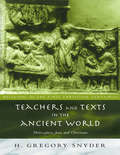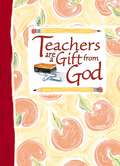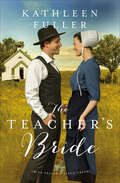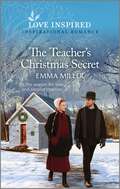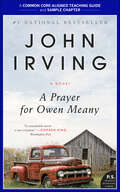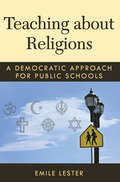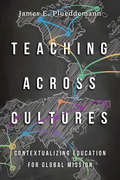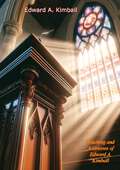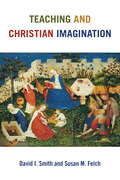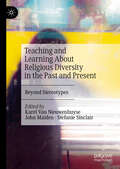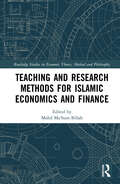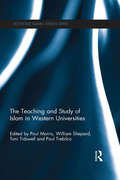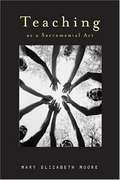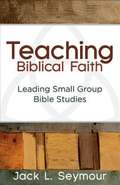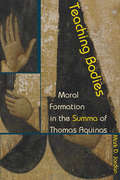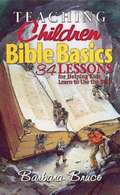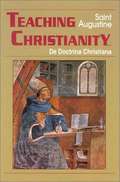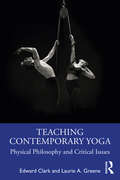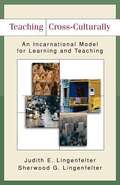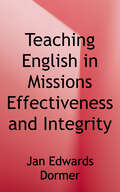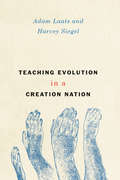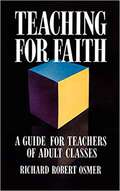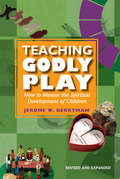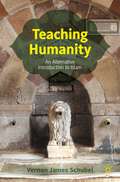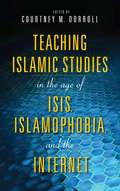- Table View
- List View
Teachers and Texts in the Ancient World: Philosophers, Jews and Christians (Religion in the First Christian Centuries)
by H. Greg SnyderTeachers and Texts in the Ancient World presents a comprehensive and accessible survey of religious and philosophical teaching and classroom practices in the ancient world. H. Gregory Snyder synthesizes a wide range of ancient evidence and modern scholarship to address such questions as how the literary practices of Jews and Christians compared to the literary practices of the philosophical schools and whether Christians were particularly noteworthy for their attatchment to scripture. Teachers and Texts in the Ancient World will be of interest to students of classics, ancient history, the early Christian world and Jewish studies.
Teachers Are a Gift from God Greeting Book
by ZondervanBlessings for teachers abound in this gift book of inspiring thoughts from authors such as Billy Graham and Kathy Troccoli. Also enjoy lighthearted school day stories from real people who have been blessed by and though teaching. Poetry and verses from the New International Version Bible will give teachers something more than just an apple to enjoy during those quiet moments when a word of encouragement can make their day.
The Teacher's Bride: The Teacher's Bride, The Farmer's Bride, The Innkeeper's Bride (Amish Brides of Birch Creek #1)
by Kathleen FullerA fun and heartwarming Amish rom-com where opposites really do attract. If there is one thing Christian Ropp will not allow in his classroom—or his life—it&’s chaos. So why is he drawn to Ruby Glick, a woman who seems to bring mayhem wherever she goes?Christian Ropp moves to Birch Creek to accept a teaching position in the rapidly growing Amish community. He&’s determined to put the rambunctious school in order as well as check another task off his list: finding a wife. Of course, that would be much easier if women were like textbooks, straightforward and logical.When an accident puts Christian out of commission, a new community member named Ruby Glick takes over his classroom. But Ruby&’s exuberant teaching style clashes with Christian's careful methods and he worries his students will never be the same.With a track record of catastrophe, Ruby always feels too clumsy, too distracted, too . . . much. Desperate for a chance to prove that she can do more than make mistakes in her life, she throws herself into her new teaching position. But when Christian can&’t seem to stay out of her way, she finds herself slipping into old, chaotic tendencies.What she doesn&’t anticipate is that Christian's heart is slowly catching up with his mind—and she, too, must decide whether to follow logic or love. The first in the Amish Brides of Birch Creek series (followed by The Farmer&’s Bride and The Innkeeper&’s Bride)A full-length novel, approximately 78,000 wordsA sweet and wholesome Amish romanceCatch up on the Birch Creek community with the Amish of Birch Creek series and Amish Letters series Praise for The Teacher&’s Bride:"A heartwarming story of unexpected romance woven with fun and engaging characters who come to life on every page." --Amy Clipston, bestselling author of A Seat by the Hearth "Kathleen Fuller has written a sweet, oftentimes humorous, romance that reminds readers that the perfect match might be right in front of their noses." --Kelly Irvin, bestselling author of the Every Amish Season series"Kathleen Fuller is a master storyteller and fans will absolutely fall in love with Ruby and Christian in The Teacher's Bride." --Ruth Reid, bestselling author of the Amish Mercies series"Kathy Fuller's characters leap off the page with subtle power as she uses both wit and wisdom to entertain!" --Kelly Long, national bestselling author"The story will captivate you from the first page to the last with Ruby, Christian, and engaging characters. You&’ll laugh, gasp, and wonder what will happen next." --Molly Jebber, Speaker and Award Winning Author of Grace&’s Forgiveness and the Amish Keepsake Pocket Quilt Series
The Teacher's Christmas Secret: An Uplifting Inspirational Romance (Seven Amish Sisters #3)
by Emma MillerThe Amish school brings them together Will his secret break them apart? When widowed schoolteacher Tobit Lapp is injured, he reluctantly agrees he needs Cora Koffman&’s help. Cora&’s still upset Tobit got the job at the Amish schoolhouse, but she agrees to teach his class till he&’s able. As they work together on lessons, a surprising friendship blossoms between them, but Tobit&’s heart is torn. He&’s falling for Cora—yet his secret could ruin everything…From Love Inspired: Uplifting stories of faith, forgiveness and hope.Seven Amish Sisters Book 1: Her Surprise Christmas CourtshipBook 2: Falling for the Amish Bad BoyBook 3: The Teacher's Christmas Secret
A Teacher's Guide for a Prayer for Owen Meany: Common-Core Aligned Teacher Materials and a Sample Chapter
by John Irving Amy JurskisFor teachersWe know that the Common Core State Standards are encouraging you to reevaluate the books that you assign to your students. To help you decide which books are right for your classroom, each free ebook in this series contains a Common Core–aligned teaching guide and a sample chapter.This free teaching guide for A Prayer for Owen Meany by John Irving is designed to help you put the new Common Core State Standards into practice."Among the very best American novels of our time."—Charlotte ObserverIn the summer of 1953, two eleven-year-old boys—best friends—are playing in a Little League baseball game in Gravesend, New Hampshire. One of the boys hits a foul ball that kills the other boy's mother. The boy who hits the ball doesn't believe in accidents; Owen Meany believes he is God's instrument. What happens to Owen after that 1953 foul ball is extraordinary.
Teaching about Religions: A Democratic Approach for Public Schools
by Emile Lester"This provocative and timely book challenges Americans to rethink what it means to take democracy and religious freedom seriously in public education. Emile Lester takes the reader beyond culture war conflicts rooted in religious divisions and offers bold, new solutions for addressing our differences with fairness and robust toleration. Instead of battlegrounds, he argues, public schools can and should be places that include all voices in ways that prepare citizens to engage one another with civility and respect. Teaching about Religionsis essential reading for all who care about the future of public schools---and the health of American democracy. " --- Charles C. Haynes, Senior Scholar, Freedom Forum First Amendment Center "More than simply a synthesis of existing scholarship, [this book is] an original contribution to the field. [The] major themes are timely, and this book might well contribute to public discussion of important issues in our culture wars. " ---Warren Nord, University of North Carolina-Chapel Hill "Arriving in the wake of a bitter battle over the place of Islam in America and in the midst of calls for greater understanding and civility, Emile Lester's new book is a timely contribution to the debate about the best ways to teach about religion in our nation's public schools. A pioneering researcher in this field, Lester offers thoughtful critiques of existing proposals as well as fresh ideas. His recommendations reflect painstaking efforts to understand the concerns of groups (most notably, conservative Christians) to which he does not belong, and a firm grasp of the difference between fostering understanding of other faiths and pressing for acceptance of them. Lester's prescriptions, always informed and fair-minded and sometimes provocative, should drive the debate forward in productive ways. " ---Melissa Rogers, Director, Center for Religion and Public Affairs at Wake Forest University School of Divinity and Nonresident Senior Fellow, The Brookings Institution Frequent news stories about the debates waged between secularists and religious conservatives have convinced most Americans that public schools must choose between promoting respect for religious minorities and respecting the interests of conservative Christians. As a result, public schools fail to teach students about the meaning and value of protecting religious liberty and consequently perpetuate mistrust across the cultural divide, further empower extremists, and obscure the fact that most Americans of all religious backgrounds share a commitment to basic democratic principles. In response, the public schools in the religiously diverse and divided community of Modesto, California, have introduced a widely acclaimed required world religions course. Drawing on groundbreaking research on the creation of and response to the Modesto course as well as on political philosophy, Emile Lester advocates a civic approach to teaching about religion in public schools that at once emphasizes respect for all views about religion and provides a special recognition of conservative Christian beliefs.
Teaching Across Cultures: Contextualizing Education for Global Mission
by James E. PlueddemannIn our globalized world, educators often struggle to adapt to the contexts of diverse learners. In this practical resource, educator and missiologist James Plueddemann offers field-tested insights for teaching across cultural differences. He unpacks how different cultural dynamics may inhibit learning and offers a framework for integrating conceptual ideas into practical experience.
Teaching and Addresses of Edward A. Kimball
by Edward A. KimballExplore the profound insights and transformative teachings of one of Christian Science’s most influential figures with Teaching and Addresses of Edward A. Kimball. This compelling collection brings together the essential writings and speeches of Edward A. Kimball, offering readers a deep dive into the spiritual wisdom and practical guidance that have inspired countless individuals on their spiritual journeys.Edward A. Kimball, a prominent Christian Science teacher and lecturer, was known for his clear and compelling articulation of the principles of Christian Science. This anthology captures the essence of his teachings, providing a comprehensive overview of his views on spiritual healing, faith, and the application of Christian Science principles to everyday life.Teaching and Addresses of Edward A. Kimball covers a wide range of topics, from the foundational beliefs of Christian Science to practical advice on how to live a spiritually enriched and healthful life. Kimball’s writings emphasize the importance of understanding the divine laws of God, the nature of true health and harmony, and the power of spiritual thought to effect positive change.The book is organized to present Kimball’s teachings in a coherent and accessible manner, making it an invaluable resource for both newcomers to Christian Science and those seeking to deepen their understanding of its principles. His eloquent addresses and insightful essays provide readers with a roadmap for spiritual growth, encouraging them to cultivate a closer relationship with God and to experience the healing power of divine Love.This Book is an essential addition to the library of anyone interested in Christian Science, spiritual healing, and the pursuit of a deeper understanding of divine truth. Edward A. Kimball’s legacy of wisdom and compassion continues to guide and uplift readers, offering timeless insights into the path of spiritual enlightenment and healing.
Teaching and Christian Imagination
by David I. Smith Susan M. FelchThis book offers an energizing Christian vision for the art of teaching. The authors — experienced teachers themselves — encourage teacher-readers to reanimate their work by imagining it differently. David Smith and Susan Felch, along with Barbara Carvill, Kurt Schaefer, Timothy Steele, and John Witvliet, creatively use three metaphors — journeys and pilgrimages, gardens and wilderness, buildings and walls — to illuminate a fresh vision of teaching and learning. Stretching beyond familiar clichés, they infuse these metaphors with rich biblical echoes and theological resonances that will inform and inspire Christian teachers everywhere.
Teaching and Learning About Religious Diversity in the Past and Present: Beyond Stereotypes
by Karel Van Nieuwenhuyse John Maiden Stefanie SinclairThis edited book explores examples of different ways in which societies and individuals have dealt with the concepts of religious diversity, toleration and peace-making in politics and law, and how these examples can inform educators and learners in (in- and non-)formal education today. Chapters introduce and analyse nine key documents: the Capitulations of Granada (1492), the Confederation of Warsaw (1573), the Peace of Westphalia (1648), the Royal Charter of Rhode Island (1663), the Declaration of the Rights of Man and of the Citizen (1789), the European Convention of Human Rights (1950), the Belfast/ Good Friday Agreement (1998), the Ohrid Framework Agreement (2001) and the Mardin Declaration (2010). In addition to explaining how each document manages toleration and peace, the authors also provide ‘clippings’, short visual and textual excerpts relating to the document under discussion. These aim to challenge thinking about the historical document and its potential significance for the present. The book’s contributors consider the past as a source of inspiration for learning in formal and informal educational contexts such as classrooms, museums and youth work. It will be of interest to teachers and scholars in history, citizenship, philosophy, ethics and religious education in schools and beyond.
Teaching and Research Methods for Islamic Economics and Finance (Routledge Studies in Economic Theory, Method and Philosophy)
by Mohd Ma’Sum BillahMethods and techniques adopted in teaching, training, learning, research, professional development, or capacity building are generally standardized across most traditional disciplines, particularly within developing countries. This is not the case, however, when it comes to the Islamic disciplines, and, in particular, in relation to the study of Islamic economics and finance, which is influenced by conventional standards and techniques. This is primarily due to the lack of availability of the requisite standards and mechanisms designed within the spirit of Maqsid al-Shari’ah. This book offers a unique resource and a comprehensive overview of the contemporary methods and smart techniques available for teaching, learning, and researching Islamic eco-finance, and it presents solutions to the challenges in implementing them. Further, the book gives deep insight into the most appropriate methodologies that could be employed empirically to explore, model, analyze, and evaluate Islamic finance theories and models, respectively. It also gives recommendations for improving learning, teaching, and research outcomes in Islamic eco-finance. The book also addresses how, in this advanced technological era, smart tools like artificial intelligence, machine learning, big data, Zoom, and the internet of things can be adapted to help equip students, researchers, and scholars with smart skills. The book will enable those studying Islamic economics and finance to grasp the appropriate tools for research and learning. Additionally, the Islamic economics and finance sector is growing at a significant rate and therefore requires the upskilling and capacity building of its human resources; thus, the book will also be highly beneficial for practitioners involved in the industry.
The Teaching and Study of Islam in Western Universities (Routledge Islamic Studies Series)
by Paul Morris William Shepard Toni Tidswell Paul TrebilcoPublic interest in the religion of Islam and in Muslim communities in recent years has generated an impetus for Western Universities to establish an array of Institutes and programs dedicated to the study of Islam. Despite the growth in number of programs dedicated to this study, very little attention has been paid to the appropriate shape of such programs and the assumptions that ought to underlie such a study. The Teaching and Study of Islam in Western Universities attempts to address two central questions that arise through the teaching of Islam. Firstly, what relation is there between the study of the religion of Islam and the study of those cultures that have been shaped by that religion? Secondly, what is the appropriate public role of a scholar of Islam? After extensive discussion of these questions, the authors then continue to address the wider issues raised for the academic community having to negotiate between competing cultural and philosophical demands. This edited collection provides new perspectives on the study of Islam in Western Institutions and will be an invaluable resource for students of Education and Religion, in particular Islamic Studies.
Teaching as a Sacramental Act
by Mary Elizabeth Mullino MooreMoore asserts that Christian vocation, and the teaching vocation in particular, can be best understood as sacramental, mediating the grace of God through ordinary creation for the sanctification of human life and the well-being of all creation. She develops her argument through three important factors: a historical-theological analysis of the Christian sacraments and sacramentality; a phenomenological study of teaching events; and a description of six sacramental movements and corresponding teaching practices as informed by Jewish-Christian traditions and Eucharistic practices. The nine detailed chapters include: Searching for the Sacred; Sacred Teaching: Education as Sacrament; Expecting the Unexpected; Remembering the Dismembered; Seeking Reversals; Giving Thanks; Nourishing Life; Reconstructing Community and Repairing the World; and Mapping the Future of Sacramental Teaching. Teaching as a Sacramental Act is ideal for students, pastors, Christian educators, spiritual directors, and pastoral caregivers who want to rethink and reshape the teaching ministry of the church.
Teaching Biblical Faith: Leading Small Group Bible Studies
by Jack L. SeymourBiblical faith is a lens for viewing life, and Jack Seymour refreshingly illustrates how the reading of scripture is a resource for ongoing theological reflection connecting experience, vocation, daily life, and faith. Teaching has concrete consequences affecting the very ways people of faith view the world and make decisions for living. It matters; it makes a difference in how people think and act. Written in an accessible style, the book provides a manageable way to inspire conversation about the many ways the Bible can be taught, the purposes and outcomes of each approach, and how biblical wisdom shapes personal and corporate decision-making. Useful strategies for leading group Bible study help congregations respond faithfully to the Biblical witness and cultivate a whole congregation approach to Bible study.
Teaching Bodies: Moral Formation in the Summa of Thomas Aquinas
by Mark D. JordanIn Teaching Bodies, leading scholar of Christian thought Mark D. Jordan offers an original reading of the Summa of Theology of Thomas Aquinas. Reading backward, Jordan interprets the main parts of the Summa, starting from the conclusion, to reveal how Thomas teaches morals by directing attention to the way God teaches morals, namely through embodied scenes: the incarnation, the gospels, and the sacraments. It is Thomas’s confidence in bodily scenes of instruction that explains the often overlooked structure of the middle part of the Summa, which begins and ends with Christian revisions of classical exhortations of the human body as a pathway to the best human life. Among other things, Jordan argues, this explains Thomas’s interest in the stages of law and the limits of virtue as the engine of human life.Rather than offer a synthesis of Thomistic ethics, Jordan insists that we read Thomas as theology to discover the unification of Christian wisdom in a pattern of ongoing moral formation. Jordan supplements his close readings of the Summa with reflections on Thomas’s place in the history of Christian moral teaching—and thushis relevance for teaching and writing in the present. What remains a puzzle is why Thomas chose to stage this incarnational moral teaching within the then-new genres of university disputation—the genres we think of as “Scholastic.” Yet here again the structure of the Summa provides an answer. In Jordan’s deft analysis, Thomas’s minimalist refusal to tell a new story except by juxtaposing selections from inherited philosophical and theological traditions is his way of opening room for God’s continuing narration in the development of the human soul.The task of writing theology, as Thomas understands it, is to open a path through the inherited languages of classical thought so that divine pedagogy can have its effect on the reader. As such, the task of the Summa, in Mark Jordan’s hands, is a crucial and powerful way to articulate Christian morals today.
Teaching Children Bible Basics: 34 Lessons for Helping Children Learn to Use the Bible
by Barbara BruceTeaching Children Bible Basics is a book of 34 Old and New Testament lessons that helps children ages 8-10 learn how to use the Bible. The lessons and activities are designed to teach children how the Bible came to be, how to use this important book, about the Torah, and about the important stories of the Hebrew and Christian Testaments. Key Features: Features 16 Old Testament and 20 New Testament lessons; Provides 30- to 45-minute experiential lessons that teach children how to use the Bible; Each lesson accommodates the needs of various learning styles; Each lesson highlights a specific desired result (for example, students will discover and retell the creation story day by day); Each lesson includes a lesson focus, a Scripture text, a section listing materials needed, various learning activities, discussion questions related to the Bible topics being "discovered," and a closing prayer. Key Benefits: Teachers will be enabled to teach children aged 8-10 basic Bible skills through interactive Bible lessons that stimulate creativity and critical thinking; Teachers will find practical help and guidance in how children can gain a working knowledge of the structure of the Bible, the organization of the books of the Bible, and the significance of the Bible to Christians; Can be used with any Bible translation.
Teaching Christianity: Works of Saint Augustine (Part I, Volume #11)
by Edmund HillIn this series New City Press, in conjuction with the Augustinian Heritage Institute, will provide the complete works of Saint Augustine for the first time in the English language. New translations, introductions and notes by renowned Augustinian scholars.
Teaching Contemporary Yoga: Physical Philosophy and Critical Issues
by Edward Clark Laurie A. GreeneTeaching Contemporary Yoga provides a novel look at how modern yoga is understood, practiced, and taught globally. Utilising perspectives from several academic disciplines, the authors offer an analysis of the current state of modern yoga and the possibilities for future experimentation and innovation. The authors draw on anthropological, performance, and embodiment theories to understand yoga practice as a potentially powerful ritual of transformation as well as a cultural product steeped in the process of meaning making. They craft a unique analysis that contrasts asana with the largely unexamined philosophy underlying the practice of vinyasa, while imagining a vibrant future for the evolution of yoga through excellence in teaching. Unlike other writings about yoga, the authors offer a critique of the current practice of yoga as both diminished and utilitarian, while providing a path to reinvigorating the discipline based on current scientific knowledge and methods for teaching and practice. Along with these theoretical perspectives and the analysis of contemporary yoga in the West, the authors offer practical applications to address the challenges of teaching yoga in a society where individualism and materialism are core values. Open-ended exercises in reflection and experimentation offer opportunities for readers to apply what they have learned to their teaching and personal practice. This is a vital guide for any yoga-oriented scholar, teacher, or practitioner and is an essential companion for contemporary teacher training.
Teaching Cross-Culturally: An Incarnational Model for Learning and Teaching
by Judith E. Lingenfelter Sherwood G. LingenfelterThe goal of this book is to help teachers understand their own culture of teaching and learning and also equip teachers to become effective learners in another cultural context, with specific focus on learning for teaching.
Teaching English in Missions: Effectiveness and Integrity
by Jan Edwards DormerEnglish Teaching is common in missions today. However, there has been relatively little discussion on what constitutes effectiveness in English ministries. <p><p>This book aims to foster such discussion. It first addresses issues of concern in English ministries and then suggests criteria for effectiveness, considerations in teacher preparation, and models for the teaching of English in missions.
Teaching Evolution in a Creation Nation
by Adam Laats Harvey SiegelNo fight over what gets taught in American classrooms is more heated than the battle over humanity's origins. For more than a century we have argued about evolutionary theory and creationism (and its successor theory, intelligent design), yet we seem no closer to a resolution than we were in Darwin's day. In this thoughtful examination of how we teach origins, historian Adam Laats and philosopher Harvey Siegel offer crucial new ways to think not just about the evolution debate but how science and religion can make peace in the classroom. Laats and Siegel agree with most scientists: creationism is flawed, as science. But, they argue, students who believe it nevertheless need to be accommodated in public school science classes. Scientific or not, creationism maintains an important role in American history and culture as a point of religious dissent, a sustained form of protest that has weathered a century of broad--and often dramatic--social changes. At the same time, evolutionary theory has become a critical building block of modern knowledge. The key to accommodating both viewpoints, they show, is to disentangle belief from knowledge. A student does not need to believe in evolution in order to understand its tenets and evidence, and in this way can be fully literate in modern scientific thought and still maintain contrary religious or cultural views. Altogether, Laats and Siegel offer the kind of level-headed analysis that is crucial to finding a way out of our culture-war deadlock.
Teaching for Faith: A Guide for Teachers of Adult Classes
by Richard Robert OsmerThis useful, theologically informed guide prepares teachers in the church, whose purpose is to awaken, support, and challenge faith. Richard Osmer offers practical suggestions for preparing good lectures and leading lively discussions. He explores four important dimensions of faith--faith as belief, as commitment, as relationship, and as mystery--and describes different teaching approaches to address each of these dimensions.
Teaching Godly Play: How to Mentor the Spiritual Development of Children
by Jerome W BerrymanA way to engage kids with scripture stories, based on the Montessori method, to build a Christian education that endures beyond Sunday school. Children learn through play. Understanding this basic premise, Rev. Jerome Berryman adapted techniques from the Montessori teaching method to develop an imaginative approach to telling scripture stories to children in a way that is at once playful and meaningful to them. Outlining specific storytelling techniques and demonstrating how to use story figures and other creative activities, Rev. Berryman models how to awaken children’s curiosity and imagination to create a personal experience of the Gospel. Incorporating up-to-date research in childhood development and instruction, Teaching Godly Play is a practical and effective handbook for religious educators to facilitate a warm and compelling experience of the scriptures for children of all ages.
Teaching Humanity: An Alternative Introduction to Islam
by Vernon James SchubelThis book introduces Islam through a "humanistic" lens, by highlighting the affective traditions and expressions associated with Sufism and Shi'ism. While most introductory books emphasize the shari’a, and especially the “Five Pillars,” as the primary defining characteristic of Islam, Vernon James Schubel provides an alternative introduction which instead underscores the importance of humanity and the human being within Islamic thought and practice. The book stresses the diversity of Islamic beliefs and practices, presenting them as varied responses to the shared multivalent concepts of tawhid (the unity of God), nubuwwa (prophecy) and qiyama (the Day of Judgment). Readers are introduced to essential aspects of Islam including the life of the Prophet Muhammad, the Qur’an, the development of the shari‘a, and the emergence of the Sunni, Shi‘a and Sufi traditions. The book concludes with a call to redefine “mainstream” Islam, as a religious tradition focused on the centrality of love and rooted in the importance of humanity and universal human virtues.
Teaching Islamic Studies in the Age of ISIS, Islamophobia, and the Internet
by Courtney M. DorrollHow can teachers introduce Islam to students when daily media headlines can prejudice students' perception of the subject? Should Islam be taught differently in secular universities than in colleges with a clear faith-based mission? What are strategies for discussing Islam and violence without perpetuating stereotypes? The contributors of Teaching Islamic Studies in the Age of ISIS, Islamophobia, and the Internet address these challenges head-on and consider approaches to Islamic studies pedagogy, Islamaphobia and violence, and suggestions for how to structure courses. These approaches acknowledge the particular challenges faced when teaching a topic that students might initially fear or distrust. Speaking from their own experience, they include examples of collaborative teaching models, reading and media suggestions, and ideas for group assignments that encourage deeper engagement and broader thinking. The contributors also share personal struggles when confronted with students (including Muslim students) and parents who suspected the courses might have ulterior motives. In an age of stereotypes and misrepresentations of Islam, this book offers a range of means by which teachers can encourage students to thoughtfully engage with the topic of Islam.
